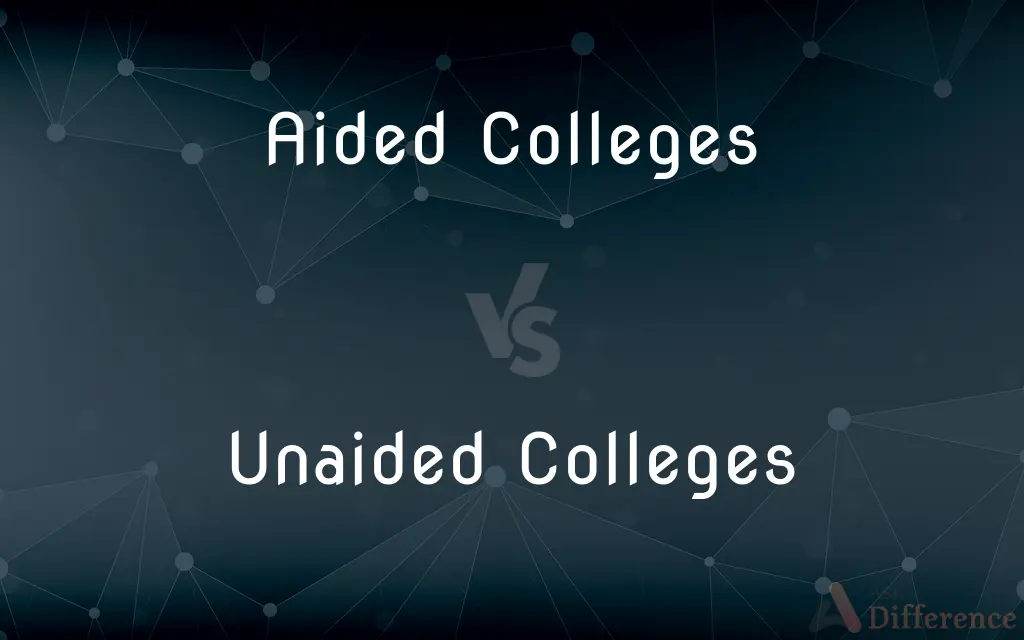Aided Colleges vs. Unaided Colleges — What's the Difference?
By Tayyaba Rehman — Published on November 15, 2023
Aided Colleges receive financial assistance from the government, while Unaided Colleges are self-financed without government support.

Difference Between Aided Colleges and Unaided Colleges
Table of Contents
ADVERTISEMENT
Key Differences
Aided Colleges refer to educational institutions that get monetary support from the government. They often have a certain percentage of seats reserved for students based on various criteria, ensuring diverse representation. Unaided Colleges, on the other hand, operate without this monetary backing. They derive their funds primarily from tuition fees, donations, and other private sources.
In the context of Aided Colleges, the government usually has a say in matters like fee structures and admission policies. Unaided Colleges, since they are independent in their funding, have greater autonomy in these areas, setting their own fees and admission standards.
Aided Colleges tend to charge lesser fees compared to Unaided Colleges because of the subsidies they receive. This makes them more accessible to students from all economic backgrounds. Conversely, Unaided Colleges might charge higher fees, but they might also offer more modern facilities, courses, or extracurricular activities due to their autonomy in fund utilization.
Another characteristic of Aided Colleges is that they might have to follow stricter government regulations and criteria. Unaided Colleges, being more autonomous, can be more flexible in their curriculum, teaching methodologies, and other institutional policies.
The decision between Aided and Unaided Colleges depends on individual priorities. While some may prefer the financial ease and regulations of Aided Colleges, others might lean towards the flexibility and modern approach of Unaided Colleges.
ADVERTISEMENT
Comparison Chart
Financial Support
Receive from the government
Self-financed
Fee Structure
Generally lower
Might be higher
Admission Policies
Might have reserved seats & government criteria
More autonomy in setting criteria
Regulations
Stricter government regulations
More flexibility in institutional policies
Sources of Funds
Government grants & subsidies
Tuition fees, donations, and private sources
Compare with Definitions
Aided Colleges
Educational bodies benefiting from state backing.
She chose an Aided College due to its inclusive admission policy.
Unaided Colleges
Institutions that are entirely self-financed.
Unaided Colleges rely on tuition for most of their revenue.
Aided Colleges
Campuses where the government aids financially.
Aided Colleges maintain a balance between autonomy and regulation.
Unaided Colleges
Colleges without government financial assistance.
He chose an Unaided College for its modern facilities.
Aided Colleges
Colleges with partial government financial support.
Aided Colleges often follow government-set guidelines.
Unaided Colleges
Educational entities not benefiting from state support.
She was impressed by the flexibility of the Unaided College's curriculum.
Aided Colleges
Institutions subsidized by the government.
Many Aided Colleges have affordable tuition fees.
Unaided Colleges
Campuses independent of government financial aid.
Unaided Colleges have autonomy in their academic approach.
Aided Colleges
Schools that get public funds to lower costs.
Aided Colleges have diverse student populations.
Unaided Colleges
Schools operating without public funds.
Unaided Colleges can set their own fee structures.
Common Curiosities
Are Aided Colleges cheaper than Unaided Colleges?
Generally, Aided Colleges have lower fees due to government subsidies.
Do Unaided Colleges have better facilities?
Unaided Colleges might offer more modern facilities due to their autonomy in fund utilization.
What are Aided Colleges?
Aided Colleges are institutions that receive financial support from the government.
Why choose an Aided College?
Aided Colleges are often more affordable and ensure diverse representation.
Can Aided Colleges set their own admission criteria?
Aided Colleges might have to follow government-set admission criteria.
How are Unaided Colleges different?
Unaided Colleges are self-financed and do not receive government financial assistance.
Are all private colleges Unaided Colleges?
Not necessarily. Some private colleges might receive some form of government assistance.
Why might one opt for an Unaided College?
For their autonomy, potential modern approach, and sometimes more diverse course offerings.
What's a potential downside to Unaided Colleges?
They might have higher tuition fees due to lack of government subsidies.
Do Aided Colleges solely depend on government funds?
No, while they receive government support, they might also have other sources of revenue.
Do Unaided Colleges follow government regulations?
Unaided Colleges have more flexibility and might not be bound by all government regulations.
Can Unaided Colleges determine their own curriculum?
Yes, they generally have more autonomy in setting their curriculum and teaching methodologies.
How do Aided Colleges benefit students?
They offer affordable education, have reserved seats for diverse criteria, and often follow standardized guidelines.
Are all Aided Colleges public institutions?
Not always. Some private institutions can also receive government aid.
Which is better, Aided or Unaided Colleges?
It depends on individual preferences and priorities, such as fees, curriculum, and facilities.
Share Your Discovery

Previous Comparison
Electoral Vote vs. Popular Vote
Next Comparison
A4 Paper Sizes vs. Letter Paper SizesAuthor Spotlight
Written by
Tayyaba RehmanTayyaba Rehman is a distinguished writer, currently serving as a primary contributor to askdifference.com. As a researcher in semantics and etymology, Tayyaba's passion for the complexity of languages and their distinctions has found a perfect home on the platform. Tayyaba delves into the intricacies of language, distinguishing between commonly confused words and phrases, thereby providing clarity for readers worldwide.












































